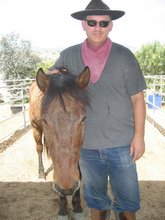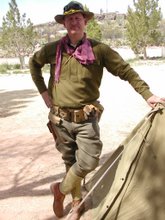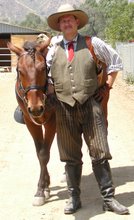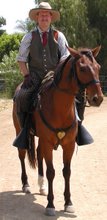One of my interests has always been the military side of things in the Old West and especially things that people don't usually associate with the West such as infantry. When it comes to living history, people often only think about Custer and the 7th Cavalry and that unfortunate encounter at the Little Big Horn. This ignores 99% of what else was out there and contrary to Hollywood movies, bad novels and other media, infantry played a key role in the Army's campaigns during the Indian Wars.
I originally posted this on another living history board but I thought that it might be of interest here...and yes, believe it not, there actually WAS infantry in the West and they were often more useful than cavalry for heavy campaigning. :-)
The following is some general information for those who would like to put together an 1870s infantry impression so here's a brief overview:
First, you have to ask yourself what year are you portraying? Uniforms and equipment were in a state of flux during this era and often times key items were different from year to year. Contrary to popular belief, soldiers were not simply issued with leftovers from the Civil War (in fact, it was due to poor storage that a lot of these items were rendered unuseable which prompted the Army to seek replacements).
With that said, I'll start with the necessary kit for an 1876 impression:
1874 Sack Coat w/ branch of service trim on the sleeves. This was a four-button sack coat, unlike its Civil War cousin.
1872 Trousers or Civil War era trousers (preferably Schuykil pattern). There is very little difference between them and both were used.
1851 or 1872 Shoe (aka brogans). Both appear to have been used throughout the 1870s and the 1872 model was made with copper screws which in turn made them especially unforfortable in the winter.
1872 Forage Cap with appropriate branch of service, company and regiment brass. These are arranged a bit differently before and after 1875.
Campaign Hat- At this point there was no official issue model (in 1877 there would be) and the soldiers bought these from the post trader or other civilian source. These would be non-descript slouch hats in a variety of colors, mostly black, brown and grey. One note: DO NOT PUT HAT BRASS OR HAT CORDS ON THESE!!! The actual soldiers rarely did so (and it wasn't authorized) and it will mark you as a farb.
1873 Greatcoat- This was a pretty warm garment and was blanket-lined and had a double-cape.
1874 Canteen- This would be a converted Civil War era canteen and there were at least two different models.
1874 Haversack- This came in two basic models, the earlier in cotton duck with a tarred cover and a later one with a thick canvas cover.
1874 Meat Can- The Army's first attempt at an issue piece of mess wear. Descendents of this basic model were used by the Army up until the late 1980s.
1874 Knife, Spoon, and Fork- Once again, the Army's first official issue eating wear. Before this, soldiers bought whatever they could at the post trader.
1874 Cup. Similar to it's Civil War cousin in size and configuration. Unlike those in the Civil War soldiers did not install wire bales and efforts were made to keep these clean (from what I can tell from the research I've done).
1874 Clothing Bag- Rarely carried on campaign, this was intended as a means carrying clothing and along with the haversack, made up the Palmer Brace System.
Blanket- Can be either the Grey pattern found in the Civil War or the later 1873 model with purple stripes (yeah, purple! ).
Gum Blanket- Same as it's Civil War predecessor (it was the same item).
Shelter Half- Identical to the Civil War model, mostly the 1864 model. Wooden stakes simliar to those found in WWI/WWII were also issued along with two-piece poles.
Prairie Belt- This was the ammo belt consisting of loops. At this time there was no official issue item like this so soldiers would purchase their own from either civilian sources or from one of the Post saddlers. Old 1851 waist belts and NOC belt buckles were popular for conversions. By 1877/78, the Army finally developed it's own issue belt.
1874 belt and McKeever Pouch. These were garrison items and along with the haversack and clothing bag made up the Palmer Brace System.
Bayonet and Scabbard. The Bayonet scabbard was developed in 1872 and the bayonet was usually a converted Civil War era bayonet (althogh there some bayonets specially made for the 1873 Springfield Rifle. The bayonet was also a garrison item and was left behind on campaign.
The above is only a rough sketch and I'm partially going off memory here so I might have gotten a few things wrong so please bear with me. Also, while it can be successfully argued that it took time for items to be put into the Army supply system and distributed to the troops out West, the process still occurred in a reasonable amount of time so using this as an excuse to use Civil War stuff really doesn't cut it.
Also, and this is a gripe of mine, all too often the "it took time to issue new items" is used as a cop-out by people to weasel out of having to expend the money and time to procure the right stuff- in some cases, it simply doesn't work and makes you look like a farb. Also, while in some instances you can justify the Civil War item, in order to really set the Indian Wars impression apart from Civil War, you really have to use the stuff that's unique to the 1870s to really stand out. Just my opinion there.
Unfortuantely, there are way too many half-assed Indian Wars infantry impressions out there (and don't get me started on cavalry) and they're not even good Civil War impressions. LEAVE THE CIVIL WAR BEHIND! OK, that's my dos centavos on that matter.
Also, just an observation: While it's easier to put together a c. 1867 impression using mostly Civil War items, procuring the 1866 Springfield (aka Second Allen) is a killer- apparently the prices have gone through the ceiling.
On the other hand, doing a more latter impression such as the later 1870s or 1880s is easier from a weapons standpoint (though not much with the prices), getting the proper unifroms and equipment is a bit more of a challenge.
Finally, the one thing really holding back things is the lack of a good uniform vendor. The only game in town is the Quartermaster Shop and the authenticity of some of their items is pretty questionable (although the workmanship is pretty decent). Perhaps things have changed but at least that's what I encountered about four or five years ago.
Just my dos centavos but I hope people find it helpful.
I originally posted this on another living history board but I thought that it might be of interest here...and yes, believe it not, there actually WAS infantry in the West and they were often more useful than cavalry for heavy campaigning. :-)
The following is some general information for those who would like to put together an 1870s infantry impression so here's a brief overview:
First, you have to ask yourself what year are you portraying? Uniforms and equipment were in a state of flux during this era and often times key items were different from year to year. Contrary to popular belief, soldiers were not simply issued with leftovers from the Civil War (in fact, it was due to poor storage that a lot of these items were rendered unuseable which prompted the Army to seek replacements).
With that said, I'll start with the necessary kit for an 1876 impression:
1874 Sack Coat w/ branch of service trim on the sleeves. This was a four-button sack coat, unlike its Civil War cousin.
1872 Trousers or Civil War era trousers (preferably Schuykil pattern). There is very little difference between them and both were used.
1851 or 1872 Shoe (aka brogans). Both appear to have been used throughout the 1870s and the 1872 model was made with copper screws which in turn made them especially unforfortable in the winter.
1872 Forage Cap with appropriate branch of service, company and regiment brass. These are arranged a bit differently before and after 1875.
Campaign Hat- At this point there was no official issue model (in 1877 there would be) and the soldiers bought these from the post trader or other civilian source. These would be non-descript slouch hats in a variety of colors, mostly black, brown and grey. One note: DO NOT PUT HAT BRASS OR HAT CORDS ON THESE!!! The actual soldiers rarely did so (and it wasn't authorized) and it will mark you as a farb.
1873 Greatcoat- This was a pretty warm garment and was blanket-lined and had a double-cape.
1874 Canteen- This would be a converted Civil War era canteen and there were at least two different models.
1874 Haversack- This came in two basic models, the earlier in cotton duck with a tarred cover and a later one with a thick canvas cover.
1874 Meat Can- The Army's first attempt at an issue piece of mess wear. Descendents of this basic model were used by the Army up until the late 1980s.
1874 Knife, Spoon, and Fork- Once again, the Army's first official issue eating wear. Before this, soldiers bought whatever they could at the post trader.
1874 Cup. Similar to it's Civil War cousin in size and configuration. Unlike those in the Civil War soldiers did not install wire bales and efforts were made to keep these clean (from what I can tell from the research I've done).
1874 Clothing Bag- Rarely carried on campaign, this was intended as a means carrying clothing and along with the haversack, made up the Palmer Brace System.
Blanket- Can be either the Grey pattern found in the Civil War or the later 1873 model with purple stripes (yeah, purple! ).
Gum Blanket- Same as it's Civil War predecessor (it was the same item).
Shelter Half- Identical to the Civil War model, mostly the 1864 model. Wooden stakes simliar to those found in WWI/WWII were also issued along with two-piece poles.
Prairie Belt- This was the ammo belt consisting of loops. At this time there was no official issue item like this so soldiers would purchase their own from either civilian sources or from one of the Post saddlers. Old 1851 waist belts and NOC belt buckles were popular for conversions. By 1877/78, the Army finally developed it's own issue belt.
1874 belt and McKeever Pouch. These were garrison items and along with the haversack and clothing bag made up the Palmer Brace System.
Bayonet and Scabbard. The Bayonet scabbard was developed in 1872 and the bayonet was usually a converted Civil War era bayonet (althogh there some bayonets specially made for the 1873 Springfield Rifle. The bayonet was also a garrison item and was left behind on campaign.
The above is only a rough sketch and I'm partially going off memory here so I might have gotten a few things wrong so please bear with me. Also, while it can be successfully argued that it took time for items to be put into the Army supply system and distributed to the troops out West, the process still occurred in a reasonable amount of time so using this as an excuse to use Civil War stuff really doesn't cut it.
Also, and this is a gripe of mine, all too often the "it took time to issue new items" is used as a cop-out by people to weasel out of having to expend the money and time to procure the right stuff- in some cases, it simply doesn't work and makes you look like a farb. Also, while in some instances you can justify the Civil War item, in order to really set the Indian Wars impression apart from Civil War, you really have to use the stuff that's unique to the 1870s to really stand out. Just my opinion there.
Unfortuantely, there are way too many half-assed Indian Wars infantry impressions out there (and don't get me started on cavalry) and they're not even good Civil War impressions. LEAVE THE CIVIL WAR BEHIND! OK, that's my dos centavos on that matter.
Also, just an observation: While it's easier to put together a c. 1867 impression using mostly Civil War items, procuring the 1866 Springfield (aka Second Allen) is a killer- apparently the prices have gone through the ceiling.
On the other hand, doing a more latter impression such as the later 1870s or 1880s is easier from a weapons standpoint (though not much with the prices), getting the proper unifroms and equipment is a bit more of a challenge.
Finally, the one thing really holding back things is the lack of a good uniform vendor. The only game in town is the Quartermaster Shop and the authenticity of some of their items is pretty questionable (although the workmanship is pretty decent). Perhaps things have changed but at least that's what I encountered about four or five years ago.
Just my dos centavos but I hope people find it helpful.












No comments:
Post a Comment